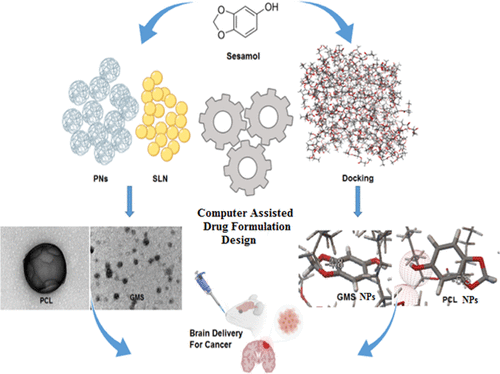当前位置:
X-MOL 学术
›
Mol. Pharmaceutics
›
论文详情
Our official English website, www.x-mol.net, welcomes your
feedback! (Note: you will need to create a separate account there.)
Synchronizing In Silico, In Vitro, and In Vivo Studies for the Successful Nose to Brain Delivery of an Anticancer Molecule
Molecular Pharmaceutics ( IF 4.5 ) Pub Date : 2021-08-30 , DOI: 10.1021/acs.molpharmaceut.1c00276 Shaymaa A Abd-Algaleel 1 , Abdelkader A Metwally 2, 3 , Hend Mohamed Abdel-Bar 4 , Dina H Kassem 5 , Rania M Hathout 2
Molecular Pharmaceutics ( IF 4.5 ) Pub Date : 2021-08-30 , DOI: 10.1021/acs.molpharmaceut.1c00276 Shaymaa A Abd-Algaleel 1 , Abdelkader A Metwally 2, 3 , Hend Mohamed Abdel-Bar 4 , Dina H Kassem 5 , Rania M Hathout 2
Affiliation

|
Sesamol is a sesame seed constituent with reported activity against many types of cancer. In this work, two types of nanocarriers, solid lipid nanoparticles (SLNs) and polymeric nanoparticles (PNs), were exploited to improve sesamol efficiency against the glioma cancer cell line. The ability of the proposed systems for efficient brain targeting intranasally was also inspected. By the aid of two docking programs, the virtual loading pattern inside these nanocarriers was matched to the real experimental results. Interactions involved in sesamol–carrier binding were also assessed, followed by a discussion of how different scoring functions account for these interactions. The study is an extension of the computer-assisted drug formulation design series, which represents a promising initiative for an upcoming industrial innovation. The results proved the power of combined in silico tools in predicting members with the highest sesamol payload suitable for delivering a sufficient dose to the brain. Among nine carriers, glyceryl monostearate (GMS) and polycaprolactone (PCL) scored the highest sesamol payload practically and computationally. The EE % was 66.09 ± 0.92 and 61.73 ± 0.47 corresponding to a ΔG (binding energy) of −8.85 ± 0.16 and −5.04 ± 0.11, respectively. Dynamic light scattering evidenced the formation of 215.1 ± 7.2 nm and 414.25 ± 1.6 nm nanoparticles, respectively. Both formulations demonstrated an efficient cytotoxic effect and brain-targeting ability compared to the sesamol solution. This was evidenced by low IC50 (38.50 ± 10.37 μM and 27.81 ± 2.76 μM) and high drug targeting efficiency (7.64 ± 1.89-fold and 13.72 ± 4.1-fold) and direct transport percentages (86.12 ± 3.89 and 92.198 ± 2.09) for GMS-SLNs and PCL-PNs, respectively. The results also showed how different formulations, having different compositions and characteristics, could affect the cytotoxic and targeting ability.
中文翻译:

同步计算机、体外和体内研究以成功地将抗癌分子从鼻到脑递送
芝麻酚是一种芝麻成分,据报道具有抗多种癌症的活性。在这项工作中,两种类型的纳米载体,固体脂质纳米颗粒 (SLNs) 和聚合物纳米颗粒 (PNs),被用来提高芝麻酚对抗胶质瘤癌细胞系的效率。还检查了所提出的用于鼻内有效脑靶向系统的能力。借助两个对接程序,这些纳米载体内部的虚拟加载模式与真实的实验结果相匹配。还评估了芝麻酚-载体结合所涉及的相互作用,然后讨论了不同的评分函数如何解释这些相互作用。该研究是计算机辅助药物配方设计系列的延伸,代表了即将到来的工业创新的一个有希望的举措。计算机工具预测具有最高芝麻酚有效载荷的成员,适合向大脑提供足够的剂量。在九种载体中,单硬脂酸甘油酯 (GMS) 和聚己内酯 (PCL) 在实际和计算上得分最高的芝麻酚有效载荷。EE % 为 66.09 ± 0.92 和 61.73 ± 0.47,分别对应于 -8.85 ± 0.16 和 -5.04 ± 0.11 的 Δ G(结合能)。动态光散射分别证明了 215.1 ± 7.2 nm 和 414.25 ± 1.6 nm 纳米颗粒的形成。与芝麻酚溶液相比,两种制剂都表现出有效的细胞毒性作用和脑靶向能力。低 IC 50证明了这一点(38.50 ± 10.37 μM 和 27.81 ± 2.76 μM)和高药物靶向效率(7.64 ± 1.89 倍和 13.72 ± 4.1 倍)和 GMS-SLN 和 PCL-PN 的直接转运百分比(86.12 ± 3.89 和 92.198 ± 2.09) , 分别。结果还显示了具有不同组成和特性的不同制剂如何影响细胞毒性和靶向能力。
更新日期:2021-10-04
中文翻译:

同步计算机、体外和体内研究以成功地将抗癌分子从鼻到脑递送
芝麻酚是一种芝麻成分,据报道具有抗多种癌症的活性。在这项工作中,两种类型的纳米载体,固体脂质纳米颗粒 (SLNs) 和聚合物纳米颗粒 (PNs),被用来提高芝麻酚对抗胶质瘤癌细胞系的效率。还检查了所提出的用于鼻内有效脑靶向系统的能力。借助两个对接程序,这些纳米载体内部的虚拟加载模式与真实的实验结果相匹配。还评估了芝麻酚-载体结合所涉及的相互作用,然后讨论了不同的评分函数如何解释这些相互作用。该研究是计算机辅助药物配方设计系列的延伸,代表了即将到来的工业创新的一个有希望的举措。计算机工具预测具有最高芝麻酚有效载荷的成员,适合向大脑提供足够的剂量。在九种载体中,单硬脂酸甘油酯 (GMS) 和聚己内酯 (PCL) 在实际和计算上得分最高的芝麻酚有效载荷。EE % 为 66.09 ± 0.92 和 61.73 ± 0.47,分别对应于 -8.85 ± 0.16 和 -5.04 ± 0.11 的 Δ G(结合能)。动态光散射分别证明了 215.1 ± 7.2 nm 和 414.25 ± 1.6 nm 纳米颗粒的形成。与芝麻酚溶液相比,两种制剂都表现出有效的细胞毒性作用和脑靶向能力。低 IC 50证明了这一点(38.50 ± 10.37 μM 和 27.81 ± 2.76 μM)和高药物靶向效率(7.64 ± 1.89 倍和 13.72 ± 4.1 倍)和 GMS-SLN 和 PCL-PN 的直接转运百分比(86.12 ± 3.89 和 92.198 ± 2.09) , 分别。结果还显示了具有不同组成和特性的不同制剂如何影响细胞毒性和靶向能力。











































 京公网安备 11010802027423号
京公网安备 11010802027423号